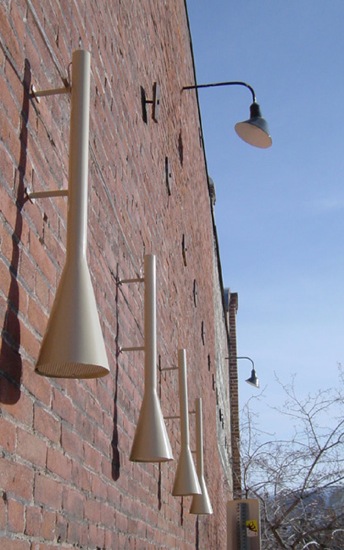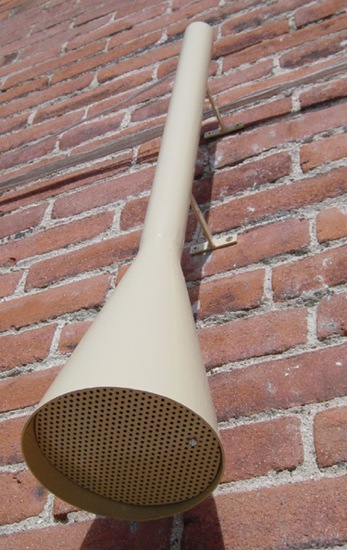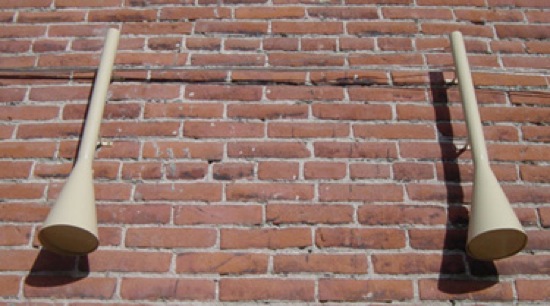2004
sound installation
sun valley center for arts
and downtown ketchum, id
nest was inspired by a small pine cone found in front of emily dickinson’s house in amherst in march of 2003. the pine cone was the only sound source used in the piece (other than a quiet backwards chord played on my father’s guitar faintly in the background).
the composition was determined by a chance procedure of dropping the pine cone on a piece of paper 100 times (as though emily dickinson and john cage had somehow bumped into each other on a street corner). the work was installed on one of the oldest historical buildings in ketchum – now the home of iconoclast books (an incredible bookstore). the speaker housings were fabricated by john o’brien.
nest was commissioned by the sun valley center for the arts as part of the exhibition sound of place/place of sound, curated by jennifer gately.
notes from 2004: in march of 2003 i was invited to amherst college to give a talk on my work. i arrived in town early and somehow ended up parking in front of an old house that turned out to be the home of emily dickinson.
the house was not open, but i was completely struck by the quiet of the place – certainly somewhat due to my own romantic notions of the house’s history – but also as the sun was setting and the street behind me was crowded with traffic and noise, this silhouetted presence in slowly disappearing winter light, was so complete in its stillness – as though the surrounding world had attempted so very hard to move forward, while this architecture remained quiet, immobile, and still. somehow, its life seemed to have seeped into its foundation and anchored or simply rooted the house and its history to this earth.
while i was standing there taking a few snapshots, i stuck my hand in the snow and found a tiny pinecone – a fragment of her landscape that would follow me home.
i thought about using the tiny object to create a soundwork, but as i tend to leave things alone until inspiration finds me, it simply gathered dust on my desk for almost a year. in january of 2004 i picked up a tiny 1925 diary at a flea market and started thumbing through it. it seems that the author, nellie alice smith, was graduating high school at the time. in the back of her diary she wrote down a few poems by goethe, emerson, and one by emily dickinson which had the line in it “or help one fainting robin unto his nest again”. i was immediately struck by the memory of this fallen baby pine cone i had ‘rescued’ from the snow, and by memories of the landscape and the house. it finally seemed relevant somehow to use the pine cone as an acoustic object to create a kind of nest in sound.
for many years i have thought of my audio work as architectural in terms of using sound to build spaces or rooms that one can wander around inside of. for nest, this aspect of my audio intentions is perfectly fitted to the idea of creating a private space within a public city space – a tiny sound womb that is a part of the landscape and yet a smaller space within it – containing its own landscape.
along with referencing architectural space, i have considered most of my field recording works as ‘possible landscapes’ – physical landscapes that have been reconfigured or translated into suggestive landscapes – in both cases, again, spaces for wandering.
with ‘nest’, i am happy that this tiny pinecone from amherst will be used to create a tiny landscape in idaho – both connected to a landscape of contemplation amidst the noise and activity of the city.
compositional approach:
the audio work began with the small pine cone – about the size of the last third of my pinky. i knew from the beginning that this would be the object of resonance for the work, but i wasn’t quite sure how it could work. i began i began with recordings of dropping it and spinning it in an old brass candy dish. these recordings were looped, stretched, dropped in pitch, and then layered in pro-tools. i thought it was the beginning of something wonderful, so i simply listened to it over and over again to try to figure out how to finish it – the background needed a foreground.
thumbing through the diary and reading the dickinson poem over and over again i chanced on a melody and did a few recordings of myself singing the tones of all the vowels in the poem over the percussive background – ‘not in vain’ became o-i-a-i . it was quite beautiful, but for some reason felt empty, overly familiar, and a little dead. i struggled with all of this for a day or two trying to fit it all together and make it work, but i was finally beaten. i trashed it, and decided to start over.
i had recently purchased an old toy called ‘computer music’ which i had been searching for for years after seeing an ad in a magazine from the early 70’s. unfortunately, it was far from my fantasy of an early computer music generating toy – but in fact, just a battery powered music box that used hole punched paper, like a player piano, to make music box sounds. for some reason, i decided to drop the pine cone onto a strip of unpunched paper a hundred times, tracing the pine cone where it landed. i then punched holes in the spots and ran the paper through the computer music machine. after 100 drops, the pine cone landed on the paper only 17 times, so the paper played 17 notes. i ran it through the machine for a somewhat beautiful ‘found’ melody. i recorded this several times, layering them, slowing them down, etc. and once again arrived at an overly familiar feeling dead end.
as i was getting ready to erase this second false start (which i did), i noticed the paper with the holes was almost the exact same size as my midi keyboard (a small piano looking keyboard that triggers my sampler). i laid the paper on the desk above the keyboard, and decided i could use the holes/pine cone silhouettes as a score for playing something on the keyboard. i then recorded the sound of the pine cone being dropped in the brass bowl, and played this sample across the keyboard, allowing the pinecone drops to determine the melody and pitch. i played the score which was divided by a fold 4 ways – once left to right, once right to left, once center to right, center to left and once center to left, center to right – all four ‘performances are layered and repeated in the final work.
i then went back to the first sample of the pine cone swirling around the bowl and laid a few tracks of that down as well as two ‘chords’ played on my father’s guitar – the note ‘clusters’ also based on the pine cone falls score – these were manipulated to play backwards and added softly to the background…


